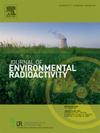Lead-210 in environmental samples –a review on the status and progress on its determination
IF 2.1
3区 环境科学与生态学
Q3 ENVIRONMENTAL SCIENCES
引用次数: 0
Abstract
Lead-210 (210Pb) is an integral component of the uranium-238 decay series and distributed throughout the environment. The interest for determining 210Pb comes from many tracer applications of the radionuclide, where one of the most useful applications is sediment dating. Meanwhile, the radiation risk through internal exposure is another concern due to its high radiotoxic daughters. The conventional approaches for 210Pb quantification have relied upon radiometric methods, an interest in using mass spectrometry for its measurement has been increased in the recent years. This article aims to present a critical review on different aspects for the determination of 210Pb, including preconcentration and separation of lead from environmental samples, followed by a comparison of the conventional radiometric methods to the mass spectrometry for its measurement.
环境样品中铅210的测定现状及进展
铅-210 (210Pb)是铀-238衰变系列的一个组成部分,分布在整个环境中。测定210Pb的兴趣来自放射性核素的许多示踪剂应用,其中最有用的应用之一是沉积物定年。与此同时,由于其高放射性毒性子体,内部暴露的辐射风险是另一个令人担忧的问题。传统的210Pb定量方法依赖于辐射测量方法,近年来人们对使用质谱法进行测量的兴趣有所增加。本文综述了环境样品中铅的预富集和分离等方面的研究进展,并对传统的辐射测定方法与质谱法进行了比较。
本文章由计算机程序翻译,如有差异,请以英文原文为准。
求助全文
约1分钟内获得全文
求助全文
来源期刊

Journal of environmental radioactivity
环境科学-环境科学
CiteScore
4.70
自引率
13.00%
发文量
209
审稿时长
73 days
期刊介绍:
The Journal of Environmental Radioactivity provides a coherent international forum for publication of original research or review papers on any aspect of the occurrence of radioactivity in natural systems.
Relevant subject areas range from applications of environmental radionuclides as mechanistic or timescale tracers of natural processes to assessments of the radioecological or radiological effects of ambient radioactivity. Papers deal with naturally occurring nuclides or with those created and released by man through nuclear weapons manufacture and testing, energy production, fuel-cycle technology, etc. Reports on radioactivity in the oceans, sediments, rivers, lakes, groundwaters, soils, atmosphere and all divisions of the biosphere are welcomed, but these should not simply be of a monitoring nature unless the data are particularly innovative.
 求助内容:
求助内容: 应助结果提醒方式:
应助结果提醒方式:


